We should begin our discussion on media with a story:
“There are these two young fish swimming along and they happen to meet an older fish swimming the other way, who nods at them and says “Morning, boys. How’s the water?” And the two young fish swim on for a bit, and then eventually one of them looks over at the other and goes “What the hell is water?”
David Foster Wallace’s commencement speech
The point of the fish story is that the most obvious thing is often the hardest to see.
My hope with this article is, by the end of it, we all become like the old fish—able to see the obvious.
For this to happen, I invited some distinguished guests:
— Marshall McLuhan, media theorist and social critic, will explain his concept of the medium is the message.
— Edward Herman and Noam Chomsky will clarify their propaganda model and the five filters any information goes through before reaching us.
— Martin Gurri analyzed like no one else the events of the last decade from the Arab Spring to the improbable rise of Trump and the electoral success of Brexit.
— My last guest would be Andrey Miroshnichenko. He’s a media futurist, journalist, and a good way to wrap up this article. He did a great job analyzing the evolution of the previous guests’ ideas.
In between, I’ll insert some goodies to complete the mosaic.
By bringing together different ideas, I hope we can have the necessary understanding to navigate the media world in a more reasonable way.
Are you ready? Let’s do it!
See you on the other end.
TABLE OF CONTENTS
I- McLuhan Galaxy: Forms Come First
- Beyond the Content
- The Invisible Environment
- The Tribal Man: The Reference Point
- Impact of the Western Phonetic Alphabet and Print
- From Literate Mechanical Age to the Electrical Age
- How All This Is Related to Mass Media
II- The Political Economy of the Mass Media
- Busting the Myth Around Mass Media
- The Beauty of a System
- What Is Propaganda?
- The Five Filters Any News Go Through
III- Welcome to the Bottom World
- The Propaganda Model After 20 Years
- Free Within the Spectrum
- Why Keeping Us Under Control? An Idea of Democracy
- Reshaping Public Opinion: A Case Study
- A Gentle Way to Manipulate a Story: Russell Conjugation
- Advertisement or Subscription Business Model?
- Pseudo-Events: The Opposite of Propaganda
IV- What the Hell Is Going On?
- Can the Internet End the Propaganda Model?
- A Tsunami Called Information
- The Rise of a New Challenger: The Public
- Tunisia: The Burning Men
- Egypt or How to Bring Down the Regime Using Facebook Events
- Trump, Brexit, and Yellow Vests
- The Public vs Authority: Who Wins?
V- We Are All Media
- A Public of Authors
- The New Propaganda Model
- From Manufacturing Consent to Manufacturing Anger
- Who’s Responsible for the Media Effects?
- Living in a Post-Truth World
- Why Media Education Is Necessary
- Final Thoughts
I- McLuhan Galaxy: Forms Come First
Beyond the Content
At my first encounter with Marshall McLuhan’s ideas, I was astonished by the connections he could make between seemingly unrelated events.
In an interview, McLuhan tells us what is an effective study of the media:
“Effective study of the media deals not only with the content of the media but with the media themselves and the total cultural environment within which the media function. Only by standing aside from any phenomenon and taking an overview can you discover its operative principles and lines of force.”
For McLuhan, the impact of the media themselves is greater than their content.
Here we should highlight that he’s using a broad definition of media.
He defines medium (plural: media) as an extension of ourselves.
For example, clothes are an extension of our skin, the wheel of our feet, and the phone of our voice.
Each one of our technologies, from a kayak to a computer, extends our bodies and senses in a specific way.
The result?
The tools that we make also make us and reshape our societies.
And this is what McLuhan wants us to pay attention to.
The Invisible Environment

Each one of our innovations amplifies an organ, a sense, or a function.
By doing so, they reshape us and our environment.
But here’s the problem.
When a new technology is introduced, it is hard for us to see its impact.
Only when a new technology replaces the old one that we realize how we’ve been impacted.
Therefore, we are always one step behind.
By using the rear-mirror view, we fail to understand the effects of new technology.
Thus, we find ourselves unprepared to face the transformations in our cultural environment.
Individualism, sexual freedom, drug abuse, nationalism, the genocide of tribal cultures, maladjusted school system, identity loss… all these and more, McLuhan links them to our technologies.
But while in the past we had time to gradually absorb technology, we don’t have this luxury anymore.
Change in our environment can happen at a rapid pace.
So it’s even more important today to understand the forces that shape our society.
Otherwise, we’ll have no control over these forces.
As McLuhan said:
“The central purpose of all my work is to convey this message, that by understanding media as they extend man, we gain a measure of control over them.”
The Tribal Man: The Reference Point

To see the scope of change, McLuhan takes the tribal man as the reference point.
The auditory sense dominates tribal communication.
When they seek information, they go to the experienced members of the tribe.
Compared to the written communication, the oral one is more powerful.
Through various intonations, the spoken words carry an emotional charge that the written words don’t have.
As a result of oral communication, the members of a tribe are more passionate, involved, and interconnected.
Even though hearing is important in tribal life, all other senses are used harmoniously.
But the moment we introduce an innovation, the sensory balance changes.
Not only our perception of the world changes but also, how society organizes itself.
This is what happened with the introduction of the phonetic alphabet and the development of the print culture.
The sight took the head of all other senses.
And when the other senses are underused and underdeveloped, it automatically leads to the impoverishment of individuals.
We are affected by the dominant mean of communication in our culture.
By overusing sight, we impact our emotions, imagination, and our ways of thinking.
The Impact of the Western Phonetic Alphabet and Print

In Understanding Media, McLuhan wrote:
“The phonetically written word sacrifices worlds of meaning and perception that were secured by forms like hieroglyph and the Chinese ideogram.”
He observed that the Chinese characters are based on sensations. They favor meaning at the expense of reason.
On the other hand, the Western phonetic alphabet is lacking sensations. It favors reason at the expense of meaning.
By separating sensations from the visual experience, the phonetic alphabet created detachment.
It only intensified with Gutenberg’s invention.
Print technology established the sight predominance. It also promoted individualism, personal point of view, and reasoning in a linear fashion.
When you read a book, you sit alone, using only your vision, and reading something structured line after line, following logical patterns.
While in tribal cultures we repress visual values, in the phonetic culture we repress feelings and emotions.
In a tribal culture, individuals are a unique blend of emotions. In a phonetic culture, individuals are standardized in their attitudes and habits.
The price for becoming phonetically literate is to have an impoverished emotional and sensory life.
This is how we end up with homogenized individuals, the mass mind, and mass uniformity.
Phonetic literacy allowed the Western world to realize great achievements, but something was lost along the way.
From Literate Mechanical Age to the Electrical Age

Gutenberg’s invention was based on a repeatable, step-by-step process.
It will become the blueprint of all mechanizations coming after.
Here’s what McLuhan said about the literate mechanical society:
“Literate mechanical society separated the individual from the group in space, engendering privacy; in thought, engendering point of view; and in work, engendering specialism – thus forging all the values associated with individualism.”
The electric age started with the telegraph.
It continued with the radio, films, television, and computers.
In the ‘60s, when McLuhan started getting famous, the internet didn’t exist yet. Although, it’s something he predicted.
The electric age ended the supremacy of the sight.
Our electric media are an extension of our entire nervous system.
In this condition, who would be satisfied with reading a book?
Literacy, in the electric age, is less important than before.
Somehow, we are returning to a tribal mode.
But there’s a problem.
When two value systems are happening at the same time, they clash with one another.
Take the education system for example.
Childs, before reaching school, had all their nervous system fired up with thousands of hours spent in front of screens and TV.
A traditional education system will seem unreal or irrelevant to them.
The natural consequence is an increasing number of dropouts.
How All This Is Related to Mass Media
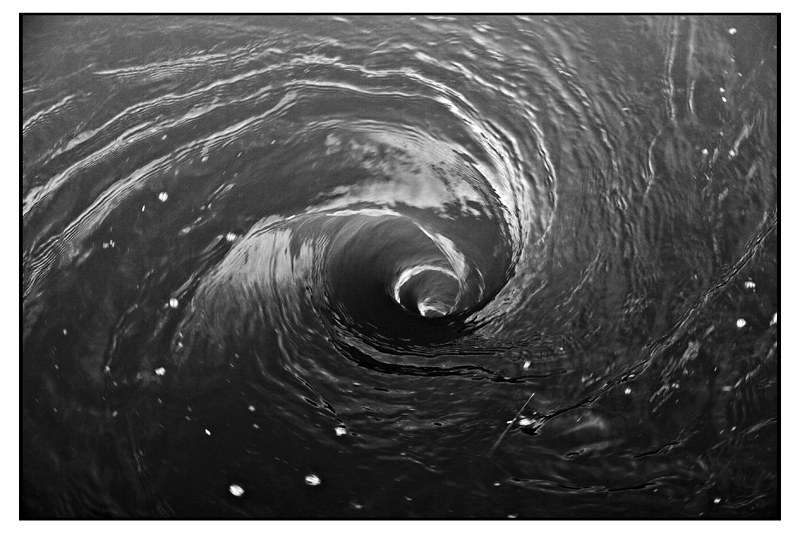
Without understanding the impact of media on us, we become their slave.
Or, as McLuhan put it, we become at the mercy of manipulators:
“Once we have surrendered our senses and nervous systems to the private manipulation of those who would try to benefit from taking a lease on our eyes and ears and nerves, we don’t really have any rights left.”
As you can see, we derived a ton of insights just from analyzing our technologies.
We haven’t mentioned any content yet.
It’s important to keep this in mind.
The technologies that mass media are using have an invisible effect.
It might even be greater than the effect of any content.
But if there’s one thing to retain from McLuhan’s work, it might be the metaphor he used a thousand times.
It’s inspired by the story of Edgar Allan Poe–A Descent Into the Maelstrom.
One fisherman was trapped in the vortex.
Although scared at the beginning, he started observing the forces at play.
Some objects were dragged down the vortex and crashed; others were brought up the vortex and rejected by it.
By studying the patterns and understanding them, the fisherman ended up riding a barrel to the safe side.
The vortex represents our total immersion in the media and technological environment.
Only by paying attention and finding patterns, we can hope to ride to the safe side.
II- The Political Economy of the Mass Media
Busting the Myth Around Mass Media
The well-known book “Manufacturing Consent–The Political Economy of Mass Media” is all about busting this myth:
“…the democratic postulate is that the media are independent and committed to discovering and reporting the truth, and that they do not merely reflect the world as powerful groups wish it to be perceived. Leaders of the media claim that their news choices rest on unbiased and objective criteria…”
The book was co-written by Herman and Chomsky in 1988.
It was before the fall of the Soviet Union and the rise of the Internet.
We’ll see later on how these two events affected their ideas.
But before going any further, we need to clarify what they mean by mass media.
This is a broad term that can include radio, television, books, magazines, newspapers, movies, or sound recordings.
Any medium of communication that reaches the masses can be part of the mass media.
I bet Manufacturing Consent is more concerned about news media than Harry Potter books!
McLuhan defined a medium (pl. media) as an extension of man.
But there is another definition of a medium:
“The intervening substance through which impressions are conveyed to the senses.”
The media are these intervening substances through which the reality of the world is conveyed to us.
Now the question is: Do mass media show the reality as it is?
For Edward Herman and Noam Chomsky, the answer is No.
Mass media are not a public service. They are not struggling against the power to tell us the objective truth.
They explain why it’s not the case and how the mass media system operates.
The Beauty of a System
In a totalitarian state, it’s easy to impose a convenient version of reality onto the people.
You can be brutal and no objection will arise. It’s a top-down intervention.
In democracies, it’s much more insidious.
That’s why people are more aware of propaganda in totalitarian states than in democracies.
In Manufacturing Consent, Herman and Chomsky lay out how the propaganda model works in our democracies.
It’s not like journalists and anchors secretly meet with the politician’s power and corporations to decide the news of the next day.
What is worthy or unworthy of coverage is internalized rather than directly imposed.
In fact, every single person working in a media group can be ethical and want to inform us the best they can.
But in the end, they will operate within certain parameters pre-set by the people in power.
This is the beauty of the system. There’s no need for direct intervention.
Before any news reaches us, it goes through these five filters: Ownership, Advertisement, Establishment, Flack, and the Common Enemy.
If you ever wondered why the media emphasize certain news and dismiss others, the five filters will help you understand.
What Is Propaganda?

Before diving into the five filters, I want to seize this opportunity to reshare the definition of propaganda.
It’s from Edward Bernays‘ book called…Propaganda (1928):
“The conscious and intelligent manipulation of the organized habits and opinions of the masses is an important element in democratic society. Those who manipulate this unseen mechanism of society constitute an invisible government which is the true ruling power of our country.
We are governed, our minds are molded, our tastes formed, our ideas suggested, largely by men we have never heard of. This is a logical result of the way in which our democratic society is organized. Vast numbers of human beings must cooperate in this manner if they are to live together as a smoothly functioning society.
…In almost every act of our daily lives, whether in the sphere of politics or business, in our social conduct or our ethical thinking, we are dominated by the relatively small number of persons…who understand the mental processes and social patterns of the masses. It is they who pull the wires which control the public mind.”
So keep in mind that, when I mention ‘power’, it’s not just about politicians.
The Five Filters Any News Go Through
To manufacture consent, you need a system that suppresses the undesirable voices and keeps the ones that serve the interests of governments and corporations.
These five filers help do that.
Al Jazeera’s short animation summarizes them well.
1-Ownership
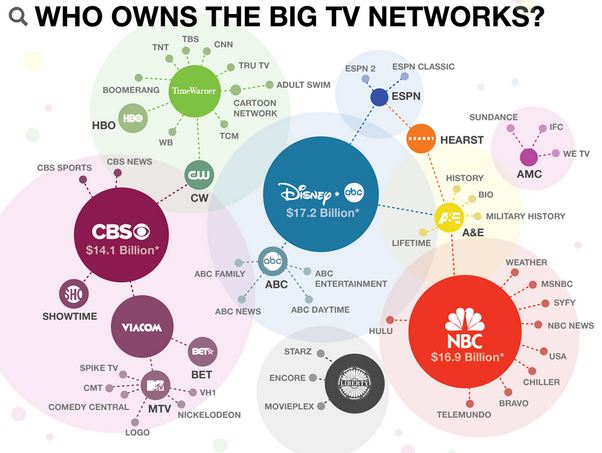
The ideology that shapes everything is the market.
The mass media, like any big corporation, are driven by profit.
Quality news or critical journalism will always come in the second place.
We might think that the diversity of media fosters the production of accurate information.
Actually, the diversity of media is just an illusion.
The reality is the concentration of media ownership.
Media concentration is a worldwide issue.
This article in Wikipedia shows who owns what in different countries.
For example, it says about the US:
“In 1983, 90% of US media was controlled by 50 companies; as of 2011, 90% was controlled by just 6 companies and in 2017 the number was 5.”
These are AT&T, Comcast, The Walt Disney Company, ViacomCBS, and Fox Corporation.
It’s not reassuring about the quality of information we’re consuming.
In sum, profit is the first powerful filter that will affect the news we receive.
2-Advertising
“In essence, the private media are major corporations selling a product (readers and audiences) to other businesses (advertisers).”
Manufacturing Consent
In a perfect world, the media will serve us quality information.
It would probably make us better humans.
But we don’t have the power of decision over the menu.
We eat what’s available.
How can it be otherwise?
Most of us don’t pay for the cost of the news; advertisers do.
Without ads, the cost of producing information will be too high.
So making advertisers happy is important for mass media.
They need to be careful with their output.
For example, programs dedicated to a low-buying power audience won’t last. It’s not lucrative for advertisers.
Also, anything complex or too controversial won’t make it.
It ruins the buying mood of the people.
For this reason, we see entertainment everywhere.
Even serious topics need to be treated in a fun way.
On paper or TV, audiences need to be relaxed so that marketers keep coming and mass media keep generating revenues.
3-The Establishment (Elite)
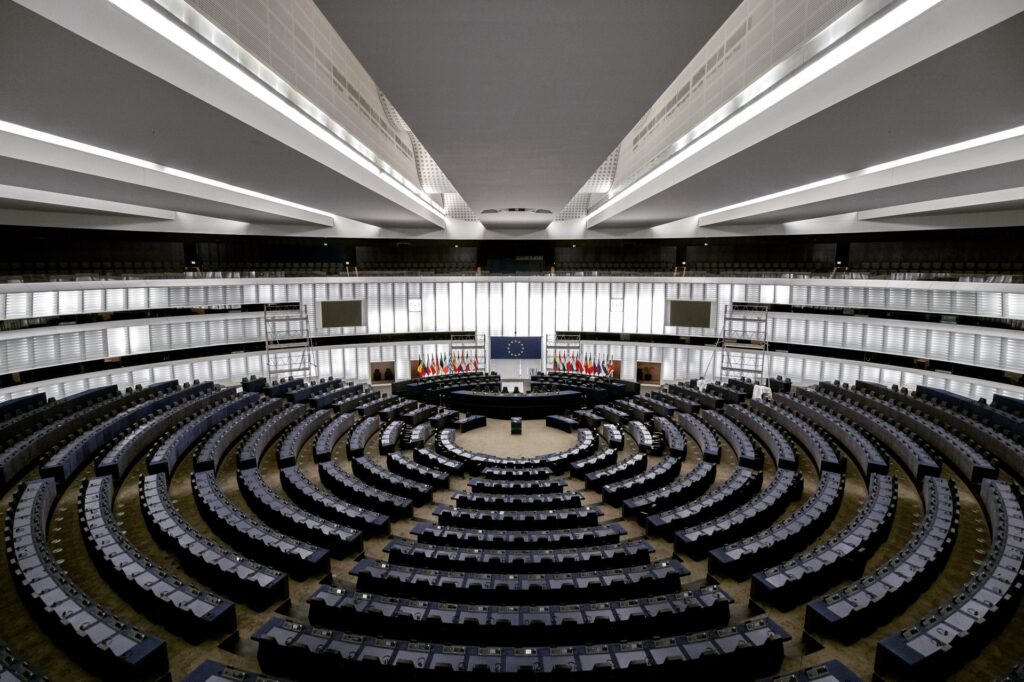
There is a mutual dependence between the powerful (governments, corporations, institutions) and mass media.
The interest of mass media is to cut the cost of an investigation.
It is expensive to send teams all over the place looking for info.
It is easier to go where the “sources” are hanging.
If you’re not too critical, you’ll keep having access to official accounts, scoops, and interviews with the experts.
But if you challenge the power, you’ll lose access. You’ll be kicked to the margins.
For the power, the interest is to influence the narrative.
By inundating the media with stories, a convenient angle is emphasized but also, it pushes unwanted stories to the marges.
The desirable narrative gets reinforced by the participation of ‘experts’.
These are the people who have some authority in a field and might challenge the official view.
By hiring them as consultants or funding their researches, the elite makes sure to silence any future dissidents.
From the interconnection of the elite, the media, and the experts emerge commonly held opinions.
This is what makes our daily news feed.
4-Flack

“Flak refers to negative responses to a media statement or program. It may take the form of letters, telegrams, phone calls, petitions, lawsuits, speeches and bills before Congress, and other modes of complaint, threat, and punitive action.”
Manufacturing Consent
The flack machine enters into action as soon as the media deviate from the established line.
Even if the media wanted to challenge the power, they can’t do so comfortably.
They know they will be a price to pay.
At the minimum, the power will discredit their sources or trash their stories.
The price can be higher if the media engage in lawsuits or lose advertisers.
Sometimes, the flak can turn to the advantage of the media.
It attracts attention to their story and allows them to gain the support of the public.
In sum, the flack is a serious consideration of the media before they publish anything challenging the power.
5-The Common Enemy

Manufacturing Consent was published in 1988.
At that time, especially in the US, the dominant ideology was anticommunism.
In today’s world, you can replace anti-communism with anti-immigrants or anti-terrorists.
As the concept is vague, it can be used against anyone that challenges the dominant narrative.
The common enemy is beneficial to the elite.
It allows to unify the population, distract them, and label as an enemy anyone who challenges the power.
“The need for enemies seems to be a common historical factor. Some states have striven to overcome domestic failure and internal contradictions by blaming external enemies. The ploy of finding a scapegoat is as old as mankind itself—when things become too difficult at home, divert attention to adventure abroad. Bring the divided nation together to face an outside enemy, either a real one, or else one invented for the purpose.”
The Club of Rome
The common enemy is a powerful filter.
Any media that goes against the dominant ideology can face consequences, either from the power or from the population.
III- Welcome to the Bottom World
The Propaganda Model After 20 Years

Herman and Chomsky elaborated their propaganda model in 1988.
Twenty years later, they were asked: What had changed?
They replied the propaganda model remained pretty much the same.
It even intensified in some sense.
With the dominance of the free-market ideology, the media has become more commercialized.
The rise of the internet didn’t arrange things.
New technologies have allowed targeting people, not only for advertising purposes but also for information acceptance.
An algorithm will serve you the information you’re most likely to agree with.
If you dislike a certain group, you’ll receive more information that reinforces your feelings.
Before, there was consensus among the media and one unifier story.
Now it’s more polarizing.
But the loser is still the same. It’s the public.
How can the media enlighten the public when the way they operate hasn’t changed?
The market dictates its reality.
So the media are still using the same common sources, they copy each other stories, and they kept the biases we spoke about before.
The result is the agenda of the elite remained unchallenged.
Free Within the Spectrum
Noam Chomsky wrote:
“The smart way to keep people passive and obedient is to strictly limit the spectrum of acceptable opinion but allow very lively debate within that spectrum….”
[The Common Good]
So to know the reality of things, we just need to find the spectrum and go beyond it.
Just to clarify here.
Herman and Chomsky don’t say the media intentionally serve us a narrow version of the truth.
They do so as a result of the five filters mentioned before.
In other words, they practice self-censoring.
This way, the political debate stays in boundaries that don’t offend the market and the state.
By narrowing the parameters of the discussion, we manufacture consent.
But wait, isn’t it contrary to democracy?
Why not giving us access to the best information possible so we can make the best decisions?
One answer could be: Do you give total freedom to kids?
Kids can hurt themselves badly if you don’t narrow the parameters of their existence.
As a parent, you can give your kids as much freedom as you want.
But if you do that, you’ll be considered irresponsible.
So you keep the kids inside fences, distract them, give them a toy, or let them watch endless cartoons.
In this scenario, the masses are seen as kids.
They can’t handle freedom as they are unaware of the dangers.
Giving them freedom within fences is actually being responsible.
Why Keeping Us Under Control? An Idea of Democracy

The media can serve as a tool for controlling us.
And they are strong arguments for controlling what the average person is consuming.
Just think of what happened during WW2.
Ordinary people turned into monsters.
This was the position of the Freudians.
Dangerous forces are sleeping below our surface and they need to be kept under control.
In democracies, the best way to keep these forces dormant is to distract people.
Walter Lippmann witnessed the insanity of WW1 and how easy was to manipulate the public.
In his famous critique of democracy, he asked:
“Can citizens achieve a basic knowledge of public affairs and then make reasonable choices about what to do?”
[Public Opinion] (1922)
His answer was no.
There are too many obstacles for the public to make sound judgments.
Too much information, lack of time, the inaccurate image of the world spread by the media…
So the solution he thought of is a bunch of experts should decide for everyone, the public and politicians alike.
Lippmann feared the public would fall prey to propaganda.
And that’s exactly what happened.
Reshaping Public Opinion: A Case Study

From a business perspective, there are also good reasons to control what the masses consume.
Imagine our society composed of three classes.
At the top, you have the true holders of power. Then you have the elected officials. And at the bottom, there are the masses. You and me.
The top class has the resources to control and manipulate the other two.
We’ll never agree that the interest of businesses is superior to anything else.
So it’s better to manipulate us.
This was the logic of Edward Bernays, a name The Muslim Shepherd readers have seen quite often in my last articles.
Normal. He’s my favorite devil 😄
In 1950, Colonel Arbenz was elected president of Guatemala.
He wanted to remove the control of the American United Fruits company over his country.
The United Fruits Company asked for Bernays’ help.
So how to explain to Americans that the company wants to keep making profits at the expense of another country?
That’s the genius of Bernays. He doesn’t explain anything.
Using media and journalists, he turned the issue into a story of communism threat to American values.
Abracadabra! The company disappeared from the picture and the question now was about saving American democracy.
Doesn’t it sound like the modern concept of war on terror? Pretty much.
This is what Bernays called engineering consent.
By using an existing fear of communism and intensifying it, he could reshape reality and manipulate public opinion in a way that serves the interests of his client.
Masterful! It deserves a round of applause 👏👏👏
A Gentle Way to Manipulate a Story: Russell Conjugation
I’ve never heard of Russell Conjugation before searching for this article. Truly fascinating.
The philosopher Bertrand Russell explained the concept in 1948.
Here’s an example:
I stand up for myself
You won’t take no for an answer
She always needs to get her way
In the three examples, the behavior is the same.
But what makes the difference is the opinion of the speaker.
The second example is less in your favor. The third one is a negative opinion.
This is how we introduce a bias into a fact.
Tom Dehnel wrote a good article explaining the concept.
He gave this real-world example from the New York Times home page in May of 2021.

You can see the contrast between the picture and the title.
The fact here is the bombardment of Gaza City.
The biased opinion is “civil unrest”. It makes the aggression sounds mild.
Once you understand the Russell Conjugation, you’ll start saying it everywhere.
You will notice when facts are narrated in a negative or minimized way.
Advertisement or Subscription Business Model?

In his article News in the Age of Abundance, David Perell defends the advertisement model.
His argument is built on the idea of common knowledge outlined by Michael Chwe.
Thanks to advertisers, we have access to free information.
It allows us to have common knowledge. Without it, no change can happen.
Let’s say you want to make a culture more diverse and inclusive
Not only do you need to know about the concept, but you also need to know that others know about it.
Common knowledge triggers collective action.
Although it makes sense, the argument doesn’t mention the quality of the common knowledge we’re sharing.
And what about the subscription model?
What can happen if people pay directly for their content?
Well, the quality of information will depend on the public desires.
If they have a short attention span, we will write 30-seconds articles on complex issues.
If they are allergic to reading, we’ll serve them pictures like an illustrated book for kids.
And if they are only interested in sex, violence, or comedy, we give them only that.
Who will pay for information that contradicts their point of view?
The media seem to be stuck in an unsolvable problem.
Either they satisfy the power and advertisers, or they satisfy the public!
Pseudo-Events: The Opposite of Propaganda

In 1962, the political historian Daniel Boorstin published his famous book The Image.
He explained pseudo-events this way:
“Pseudo-events make simple facts seem more subtle, more ambiguous, and more speculative than they really are. Propaganda oversimplifies experience, pseudo-events overcomplicate it.”
TV altered the perception of people.
The public started demanding more and more new and entertaining things.
But in the real world, events don’t happen that fast.
So how do we fill the gap? With pseudo-events.
We consume two types of news.
The first one is spontaneous and fact-based. Just like an earthquake, they happen by themselves.
The second is planned, man-made, and ambiguous. Their purpose is to grab attention and gain coverage.
When no spontaneous events are available, the media create pseudo-events.
It includes stories on celebrities and politics, unfounded predictions, or TV reality.
Boorstein wrote:
“The successful reporter is one who can find a story, even if there is no earthquake or assassination or civil war. If he cannot find a story, then he must make one—by the questions he asks of public figures, by the surprising human interest he unfolds from some commonplace event, or by ‘the news behind the news.”
Reality and illusion are so mixed up in our societies that it’s hard to differentiate them.
But the worst might be: Do we start liking to be fooled?
IV- What the Hell Is Going On?
Can the Internet End the Propaganda Model?

And it’s here that we’ll get to the core of the problem.
For Herman and Chomsky, the internet won’t change anything.
In their interview The Propaganda Model 20 Years Later, they evoked a couple of reasons:
(1) The traditional media are present on the internet and they dominate the making of news.
(2) They come to the internet with their previous audiences and have the resources to shadow potential rivals.
(3) The alternative media on the internet also depend on the advertisement. It compromises their alternative character.
(4) New media on the internet don’t make news. They are more oriented toward facilitating social connections. Alternative media are more specialized in critical analysis of existing news.
The effectiveness of propaganda doesn’t depend on the internet alone.
It varies in function of the audience knowledge, the type of fear the propagandists are triggering, how intense is the campaign, the level of cooperation of the media with the elite.
But the core of the problem, Herman and Chomsky said, is our highly unequal and unfair economic and social orders.
As long as extreme inequalities exist, the elite will have a problem justifying themselves.
So they will continue resorting to propaganda to protect their interests.
A Tsunami Called Information
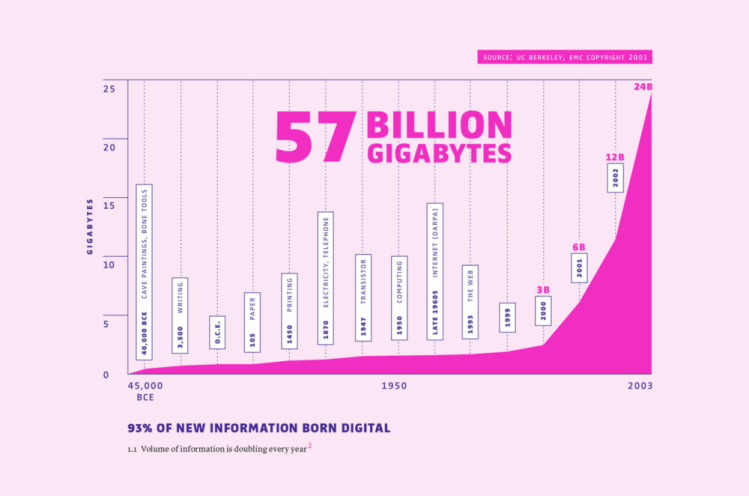
There was a world before the year 2000. And it will never be the same again.
In The Revolt of the Public, Martin Gurri wrote:
“More information was generated in 2001 than in all the previous existence of our species on earth. In fact, 2001 doubled the previous total. And 2002 doubled the amount present in 2001, adding around 23 “exabytes” of new information—roughly the equivalent of 140,000 Library of Congress collections.”
The elite of the 20th-century used to have control over information, and by extension, over public communications.
The elites were happy with globalization and the mobility of capital.
But, I guess, they didn’t imagine the mobility of information will turn against them.
As Martin Gurri wrote:
“Uncertainty is an acid, corrosive to authority. Once the monopoly on information is lost, so too is our trust. Every presidential statement, every CIA assessment, every investigative report by a great newspaper, suddenly acquired an arbitrary aspect, and seemed grounded in moral predilection rather than intellectual rigor. When proof for and against approaches infinity, a cloud of suspicion about cherry-picking data will hang over every authoritative judgment. ”
You’ve certainly noticed the truth of this quote with the debates around Covid vaccines.
It’s here where I find the ideas of Herman-Chomsky and Gurri connect well.
One looks at the dynamics pouring from the top; the other looks at ones arising from the bottom.
Right in the middle, we have our media—forms and content.
The Rise of a New Challenger: The Public
Under our very eyes, a new revolution is taking place.
It concerns the relationship between the public and authority.
Before, the elites could easily persuade the docile masses.
But once the monopoly over information was lost, things start changing.
As Martin Gurri wrote:
“A generation ago, the public could exist only as a passive audience. Information was dispensed on the industrial model: top-down and one-to-many… People from nowhere, free of institutional entanglements, pushed the elites out of the strategic heights of the information sphere. Almost immediately, great institutions in every domain of human activity began to bleed authority—a process that, as we have seen, is now approaching the terminal stage for many of them.”
The public operates differently from the elites.
It’s more networked and egalitarian.
Perfect amateurs and ordinary people can know information before the authorities.
They can also share information the elites used to keep secret.
The clash of different information is actually the clash of two operating modes.
One is hierarchical and top-down; the other egalitarian and bottom-up.
The more the public has access to information, the more the elites lose authority.
The elites don’t like it and attack any alternative source of information.
This behavior from another century is unacceptable for today’s public.
Using different media, they respond by organizing revolts.
In different parts of the world, we see these dynamics at play.
Tunisia: The Burning Men

Everyone knows Mohamed Bouazizi, the catalyst of the Tunisian revolution and ultimately, the Arab spring.
Before Bouazizi set himself on fire on the 17th December 2010, someone else did the same nine months before.
Abdesslem Trimech, another Tunisian street vendor, set himself on fire over mistreatment by the government.
His death had no consequences.
The difference between the two, said Martin Gurri, is an image.
Bouazizi burned in front of a camera. Trimech did not.
How powerful is the visual over the text!
You looked at the picture and your emotions were instantaneously aroused.
How many words would I need to arouse you the same way?
This is what McLuhan said about our new media. They are extensions of our entire nervous system.
In a second, we are filled with pain and horror.
We think of the humiliations Bouazizi went through; the level of pain he must have felt to commit such an act.
We look at the picture like it’s happening outside our window.
After pain, we are filled with rage. And it’s directed towards the rulers who pushed this man to self-immolation.
The picture was shared on Facebook.
It set the heart of people on fire in and out of Tunisia.
The rest is history.
In its footage of the Tunisian revolution, Al Jazeera mostly used videos taken by the public.
Armed with cell phones, the public became a media.
Within weeks, the authoritarian Ben Ali regime was overthrown.
Egypt or How to Bring Down the Regime Using Facebook Events

Similar to the Tunisian revolt, the 2011 uprising in Egypt started with an image.
Khaled Said was savagely beaten to death by Egyptian security forces.
It’s horrifying to see the contrast between his good-looking and deformed face.
During the 30 years of Hosni Mubarak in power, abuses like this one happened in public silence.
But this time, it was different.
Said’s family secretly snapped a picture using a cell phone and released it online.
Wael Ghonim saw the picture.
At that time, he was 29, located in Dubai, and working as Google’s head of marketing for the Middle East.
He created a Facebook page called We Are All Khaled Said.
Rapidly, the page attracted hundreds of thousands of followers.
Inspired by the events in Tunisia, Ghonim created a Facebook Event.
January 14, he called for a Revolution Against Torture, Poverty, Corruption, and Underemployment.
By January 25, the day of the protest, over a million persons viewed the event (according to Ghonim).
Two days later, he was kidnapped by the authorities and released 11 days later.
On 7 February, he gave an emotional interview on the Egyptian channel Dream TV.
HIs video went viral on YouTube.
The combined effects of old and new media got the best of Hosni Mubarak.
Four days after the interview, he was done.
Even shutting down the internet couldn’t prevent this outcome.
Information is no more under the exclusive control of authorities.
Trump, Brexit, and the Yellow Vests
The public is everywhere the same.
It gathers around the shared interest of opposing the established order.
The Yellow Vests gathered to kick out Macron. The Brexiteers united to get out of the EU. And Trump voters mobilized to liberate Washington from an old system.
To the surprise of the elites, these events happened despite mass media supporting them.
Take Donald Trump for example.
The New York Times gave him a 15% chance of winning. Some 2%.
Trump lacked all the advantages of Hilary Clinton.
He didn’t have the experience, the connections, the endorsements, or the ideological following.
If you add to this his peculiar declarations, his election is from the realm of the impossible.
But the public decides otherwise.
As Martin Gurri wrote in The Revolt of the Public:
“In the end, Trump was chosen precisely because of, not despite, his apparent shortcomings.”
The public saw in Trump a way to smash the established order.
The same for Brexit.
Pro-European voices from the establishment were loud. And the public voted out because of it, not despite.
Just like the Yellow Vests, the public gathers first in the digital world. Then it appears in the reality as if by magic.
From Tunisia to the US, the common point is standing against.
The Public vs Authority: Who Wins?
I was wrong.
This is how Wael Ghonim comments his own saying of 2011: “If you want to liberate a society, all you need is the internet”.
In regards to revolutions or protests, social media come handy.
They facilitate coordination.
However, they don’t solve this problem: What to do next?
It’s easier to unite to bring something down. But it’s much harder to unite and build something up.
Now the public sees what used to be unseen.
So they revolt against the establishment with protests or voting for populists.
But without a leader, you can’t negotiate with the power.
That’s the weakness of the digital path.
All it’s left is nihilism—the will to destruction with a disregard to the consequences.
The Public revolts, but without having any alternative to the existing establishment.
On the other hand, you have the authorities.
They defend certain privileges. And they won’t renounce them for the sake of the public.
Before the digital era, they could get away with it.
Using mass media, they had the monopoly of reshaping reality.
Not anymore.
When authorities show arrogance, the public responds with anger.
The result, as Martin Gurri wrote in his book:
“The result is paralysis by distrust… Bureaucratic inertia confronts digital nihilism. The sum is zero.”
The question we are left with is: For how long we can live without trust?
V- We Are All Media
A Public of Authors
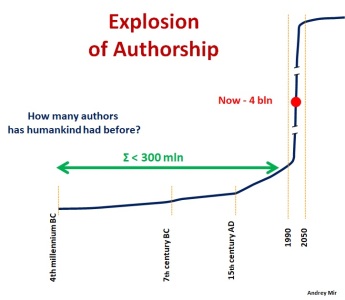
A good way to close this article is to explore the ideas of Andrey Miroshnichenko (known as Mir).
He said that the real paradigm shift of the last 20 years is The Emancipation of Authorship.
He defines it this way:
“The Emancipation of Authorship is the potential given to the majority of citizens to promote (or publish) their ideas far beyond their immediate circle. This change in the producer-consumer paradigm of previous media platforms is the true revolution of social media.”
Nowadays, everyone is an author.
We express ourselves through blogs, tweets, Facebook comments, or by posting a cat video.
In Human as Media, Mir provides us a perspective:
“Humankind had had hardly more than 300 million authors… All of a sudden, the number of authors has grown tenfold and reached four billion.”
The proliferation of authors helped to break the monopoly over information.
But for the rest, the harm outweighs the benefit.
Most authors out there are not publishing to find truth or creating beneficial knowledge.
They are there for attention. Any kind of response from the audience is welcomed.
As Mir wrote:
“With no formal training, no gatekeepers or editors and often little effort or thought, one is liberated, empowered and rewarded just in getting a response. Any response.”
In addition, new media like the internet favors shallowness and emotionality.
The result is what Martin Gurri described in The Revolt of the Public.
The New Propaganda Model
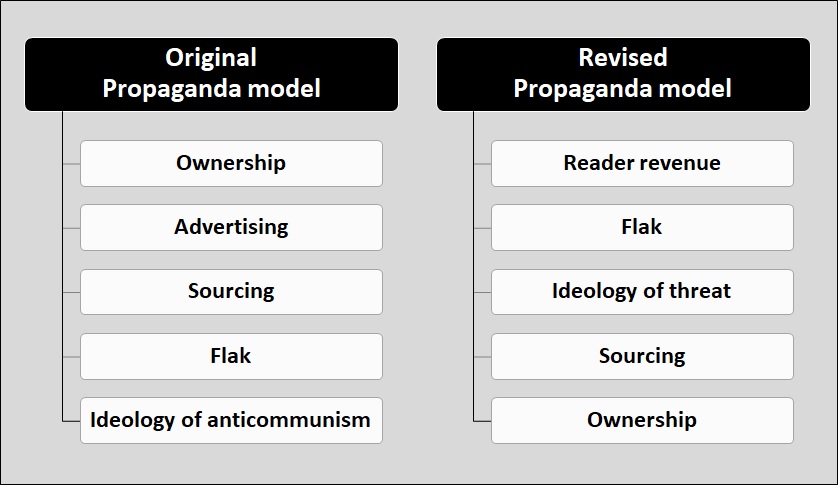
Andrey Mir revised the Herman-Chomsky propaganda model to match the reality of today.
A couple of observations here.
The Ownership filter moved to the last place. Advertising disappeared. Sourcing (the establishment) lost one place. Flak became the second most important filter, followed by the ideology of threat.
As the internet stole the ads revenues, news media turned to the readers.
Now, the audience is asked to support journalism, not to buy news.
News is no longer a commodity.
Anytime you go through your social media newsfeed, you have news for free.
The internet has also changed the nature of flak.
In the 70-80s, news media didn’t have to worry about condemnations from the public. They could simply ignore them.
They only needed to be careful with the flak coming from the elites.
Today, something as simple as a tweet can cost billions to a company.
So news media are extra careful with what they produce.
The cancel culture is one manifestation of this new reality–the audience is terrifying.
But why ownership is not as important as before?
Firstly, the emancipation of authorship made the flak more powerful.
Secondly, the news must fit the digital world.
The power moved then from the ownership of the media to the ownership of platforms.
The rulers of this new world are mainly Google and Facebook.
This redistribution of power was highlighted by Emily Bell when she said:
“In encouraging the world to publish, the platform technologies now have a social purpose and responsibility far beyond their original intent. Legacy media did not understand what it was losing, Silicon Valley did not understand what it was creating.”
From Manufacturing Consent to Manufacturing Anger

Polarization is the actual business model of both news and social media.
Let’s start with the second one.
Social media are based on user engagement.
An increase in user activity helps to collect more data. And more data means better ad targeting.
To have engagement, the system incentivizes the extremes.
Moderate content doesn’t catch the audience’s attention.
As Andrey Mir wrote:
Polarization is an inherent by-product of social media.
Concerning the news media, their revenues depend on the readers.
As the news is already free, what the readers are looking for?
Confirmation or condemnation of the news they already know.
They are looking for comments and political judgment.
Here again, moderation is not a lucrative business model.
To get the readers to buy, you need to trigger anxiety, frustration, and fear.
The more you politicize, the more you polarize.
As Andrey Mir wrote:
“A media system based on ad revenue manufactures consent. A media system based on soliciting the audience’s support manufactures anger. The ad-driven media produced happy customers. The reader-driven media produces angry citizens. The former served consumerism. The latter serves polarization.”
For Mir, the right question to ask is not how to get rid of polarization, but how to live with it.
Who’s Responsible for the Media Effects?
We can put social media on trial and blame them for everything.
And social media can blame us for the use we do of their platforms.
A good way to see clear through this is to separate the effects of the media from the user’s intent.
In general, the approach focusing on users sees the media as a neutral tool.
If you use your knife to kill someone instead of cutting veggies, it’s not the knife’s fault.

This is the thinking behind the Lasswell formula.
Everything starts from the user.
We track the user’s activity to know the goals behind their communication.
In this scenario, the media is merely an instrument for transporting the information.
On the other hand, you have the McLuhan approach.
We went through his ideas at the beginning of this article.
McLuhan didn’t care about theories of transportation. He focused on transformation.
He saw that the media are more than instruments. They change our environment.
If your environment turns you into a psychopath, it’s clear how you’ll use your knife.
Once our environment changes, we change as well.
So the harm of the media depends not only on the users but also, on the media themselves.
Living in a Post-Truth World

Hans Rosling, the author of Factfulness, wrote:
“It’s not the media’s role to present the world as it really is. They (media) will always have to compete to engage our attention with exciting stories and dramatic narratives. It is upon us consumers to realize that news is not very useful for understanding the world.”
And this raises the question: Are we sure people want the truth and an accurate presentation of the world?
In 2016, Oxford Dictionary declared post-truth to be the Word of the Year.
Here’s how they defined it:
“Post-truth is an adjective defined as ‘relating to or denoting circumstances in which objective facts are less influential in shaping public opinion than appeals to emotion and personal belief’.”
This choice of post-truth came in the context of Trump’s election and Brexit.
In a post-truth world, rational knowledge and established facts are powerless.
They are replaced by factoids and emotionally generated opinions.
A factoid is either an invented or assumed statement presented as a fact.
Why do we choose factoids instead of facts?
I don’t know. Maybe it’s a matter of taste.
As Andrey Mir wrote:
“The problem is that a factoid is good; too good for the audience to want truth instead. The truth is not as good as a factoid is.”
In the end, the media will serve us what we’re asking for.
Why should journalists investigate an affair for months if there’s no audience for their work?
Today, a 200-word article, a tweet, or a viral video can generate more return than months of effort.
We lowered our standards and the media lowered theirs.
Why Media Education Is Necessary
In one of his final interviews, McLuhan warned us about what’s coming:
McManus: You predicted the world was becoming a Global Village…But it seems, Dr. McLuhan, that this tribal world is not friendly?
MM: Oh, no, butchering each other is a full-time sport in tribal societies.
Violence is among us. And it’s only intensifying.
All the ingredients are here to keep it going.
Polarization. Rise of the extremes. A nihilist public. A paralyzed elite.
Everything is mixed up.
Truth and lie. Bad and good. Reality and fiction. The old and the new.
From the collusion of these antagonist forces, something new will emerge.
Something we don’t even have the name for yet.
But the question is: How much damage will be inflicted before a new system emerges?
Without understanding the media, we can only make things worse.
That’s why media education is necessary.
We need more of the old fish who can see the water.
People who can distinguish the signal from the noise, balance reason and emotion, and move from the extremes to the center.
To neutralize the harm of the media, we need to frequently change environments and tools.
Disconnect from the media and immerse yourself in them.
Read books and watch videos.
Surf on social media and have conversations around a dinner table.
Have group activities and seek solitude.
Only by varying our activities, we can hope to see clear.
To survive the vortex, we need to stay alert!
Final Thoughts

Kudos to you for making it so far!
We’ve covered a lot of ground.
Some ideas seem to contradict each other.
For me, I see them all as valid.
We are in a transition phase from the old to the new.
So it’s normal to have different ideas present at the same time.
By knowing them, we can navigate our troubled times in a better way.
This world is a curse for mindless consumers.
They get immersed into the media ocean without gears.
Dragged to the bottom, they get stuck with negative stories, stereotypes, and entertainment.
As a consequence, they are easily fooled, manipulated, or misinformed.
On the contrary, there are savvy consumers.
For them, this world is a remarkable opportunity to learn and sharpen their minds.
They can see through the fog and read between the lines.
They can navigate different media and keep control over them.
This article is far from covering “everything we need to know about media”.
But I believe the big principles are there.
From them, we can derive the power to see things as they are.
Article posted the 28 September 2021
Popular Articles
- For or Against Vaccines? That’s Not Really the Question
- Islamic Psychology: A Model Where Faith Has Its Place
- Blindness: From the Invisible Gorilla to the Quranic Perspective
- Muslims’ Unity: A Powerful Solution That Takes Its Time
- The Certainties of Muslims in Uncertain World
- Mongols Invasions: Some Forgotten Lessons to Today’s Muslims
- How to Enjoy Salat and Make it Meaningful
- Are Muslims Meant to Be Sleep Deprived?
- 7 Lessons from Luqman that Will Make You Wise
- How to Make People Change their Mind: Persuasion!
- A Few Thoughts For Muslims
- How to Honor the Prophet?
- Muslims Judging Each Other: Why and How to Be Less Judgy




